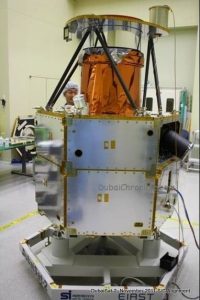- Final development model is put through its paces with heat, shock and vibration tests
- Project demonstrates His Highness Sheikh Mohammed bin Rashid’s commitment to developing a knowledge base among UAE youth, says Al Mansoori
 Engineers from the Emirates Institution for Advanced Science & Technology (EIAST) announced that the DubaiSat-2 project has completed a crucial stage in the design phase, with the qualification model (QM) passing a series of rigorous tests.
Engineers from the Emirates Institution for Advanced Science & Technology (EIAST) announced that the DubaiSat-2 project has completed a crucial stage in the design phase, with the qualification model (QM) passing a series of rigorous tests.
The Qualification Model is the third and final design model, and represents the last test of all components on DubaiSat-2, the UAE’s second remote sensing satellite which is due to be launched into orbit by the end of 2012. The model is very close to the final satellite, but has been made with less space worthy components.
 Ahmed Al Mansoori, Director General of EIAST, said: “I am delighted that the EIAST engineers have passed this significant milestone, which reflects the dedication, expertise and commitment of our team of highly skilled UAE engineers. The strive to bring to reality the vision of His Highness Sheikh Mohammed Bin Rashid Al Maktoum, UAE Vice President & Prime Minister and Ruler of Dubai, which is to propel our youth towards the cutting edge of advanced scientific research and development”.
Ahmed Al Mansoori, Director General of EIAST, said: “I am delighted that the EIAST engineers have passed this significant milestone, which reflects the dedication, expertise and commitment of our team of highly skilled UAE engineers. The strive to bring to reality the vision of His Highness Sheikh Mohammed Bin Rashid Al Maktoum, UAE Vice President & Prime Minister and Ruler of Dubai, which is to propel our youth towards the cutting edge of advanced scientific research and development”.
The DubaiSat-2 Qualification Model has been put through a series of tests to ensure the final satellite can withstand the harsh environment of the launch and its long mission in space. Tests included vibration testing, acoustic testing, thermal testing, thermal vacuum testing, a shock test and mass measurement.
“These tests are designed to put the satellite through the same or similar conditions that it will face on its journey to space. From lift off to separation of the satellite from the launcher, it takes 15 minutes, but the amount of pressure, shock and vibration is very high and we need to put the model through those same conditions to make sure our satellite will eventually survive this event” said Salem Al Marri, Head of projects and space missions at EIAST.
Al Marri added: “We also need to make sure our satellite will survive in space. Because it orbits the Earth every 90 minutes, it will be in front of the sun for about 60 minutes and behind the Earth for the rest of the time, and will therefore be subjected to huge changes in temperature. This testing phase ensures that the final satellite will cope with this.”
All of these tests were completed in early October. The next step for the engineers behind the project is one last verification of the data from the electronic components before a meeting is held at the end of February to review the data and confirm that the project is ready to enter the manufacturing stage.
The satellite will orbit 600 km above the earth’s surface compared to the 690 km orbit of DubaiSat-1. The orbit has also been changed from an ascending obit (South to North) to a descending orbit (North to South), which will allow both satellites to work well in constellation as well as give better coverage of the UAE area.
Among other significant improvements, the UAE team along with their South Korean Partners (Satrec Initiative) have designed the satellite to produce higher quality images at 1 meter resolution which can serve various applications including environmental projects, urban planning, infrastructure, telecommunications and electricity projects.
The DubaiSat-2 project is a joint development programme between EIAST and Satrec Initiative of South Korea, in which 16 UAE engineers have been working on the design, development, testing and manufacturing of the satellite. The participation of the UAE engineers, who are currently working in South Korea, has increased by 100 per cent from the DubaiSat-1 project and it is hoped that this will take EIAST to the next level in satellite development.




































